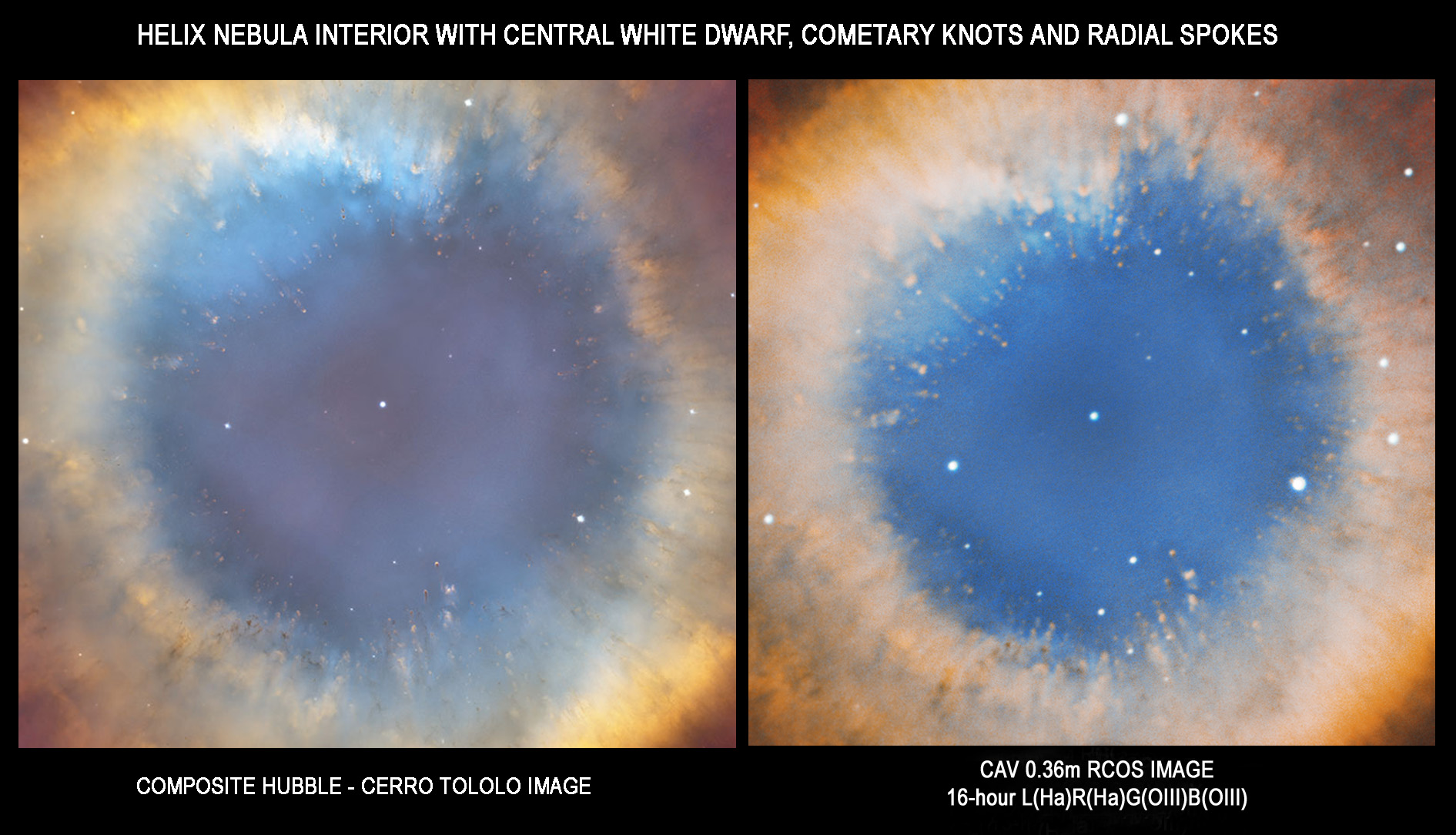Visually, planetary nebulae were some of my favorite objects when I did my fair share observing a few years ago. Many planetary nebulae are bright and compact and withstand considerable magnification. Some even have a bit of color visually! The Helix Nebula (NGC7293) in Aquarius, called by some the “Eye of God”, wasn’t very high on my list of favorite visual planetaries because of its low surface brightness and relatively low altitude spending most of its time veiled in 2 atmospheres of murk at most mid-northern latitudes (where I observed). On the other hand, the Helix Nebula is one of the best planetary nebs to study photographically because of its proximity (700 l.y.) and size (~20-25 arcmin), that is, if you can deal with the seeing effects of low altitude. When I recently saw Don Goldman’s OIII image of the Helix Nebula with radial spokes, I decided the Helix was due a visit from Mt. Binky. The Hubble Space Telescope (HST) made a detailed 14-day/night visit to the Helix in 2002 when the scope was faced away from the oncoming debris stream of the Leonid meteor shower. The resulting work done on the Helix Nebula at that time has formed the foundation of understanding of the evolution and morphology of planetary nebulae. The data from that Hubble imaging expedition was soon made public and numerous studies piggybacked on that valuable data. My favorite article was written in conjunction with images made with the 4-meter Blanco scope at (CTIO) Cerro Tololo Int’l Observatory (“Unraveling the Helix Nebula: Its Structure and Knots” – Classic Study: O’Dell et al. The Astronomical Journal, 128: 2339-56, 2004 November). This article (link below) is the source of comparison material for my attached images with the CAV 0.36 meter RCOS using Astrodon 5nm bandpass hydrogen-alpha (Ha) and oxygen III (OIII) narrowband filters (8 hours of total exposure per filter) in Oct 2010.
It amazes me that the CAV RCOS could resolve those tiny cometary knots despite most of the imaging occurring while looking, through not one, but two atmospheres at ~30 altitude. Remember – the HST imaged through NO atmosphere! To accentuate the OIII radial spokes, I inverted the OIII RCOS image and used several high pass filters in Photoshop (at radii up to 40 pixels!) and also used an emboss filter to approximate the HST-CTIO radial image (last image shown above). The deep inverted Hydrogen-alpha CAV-RCOS image shows not only the subtle bipolar nature of this planetary but also a second gas disc aligned almost perpendicular to the main ring disc. I was curious why this dying star in the Helix burped shells of gas rather than end in a supernova explosion like the Crab Nebula or Cassiopeia A. Apparently, it has to do with the mass of the star. Our Sun will likely die in the Helix fashion (shed a planetary nebula) rather than as a supernova. Supernovae happen to rare high-mass stars (read more below about this in the excellent Bakersfield College handout – link below).
http://iopscience.iop.org/1538-3881/128/5/2339/pdf/1538-3881_128_5_2339.pdf – O’Dell article – Great reading for anyone interested in planetary neb morphology!!!
http://www.astronomynotes.com/evolutn/s6.htm – AMAZING DISCUSSION of Planetary Nebs Vs. Supernova Remnants -Bakersfield College, California
http://apod.nasa.gov/apod/ap041229.html – 2004 APOD using HST and CTIO







